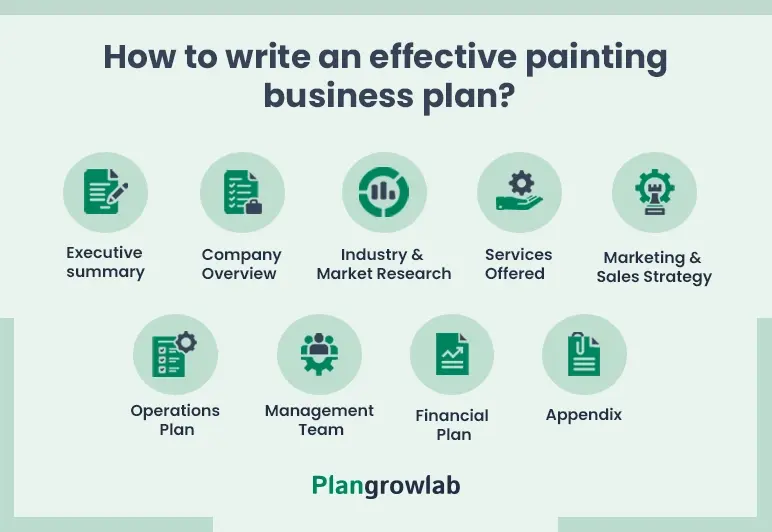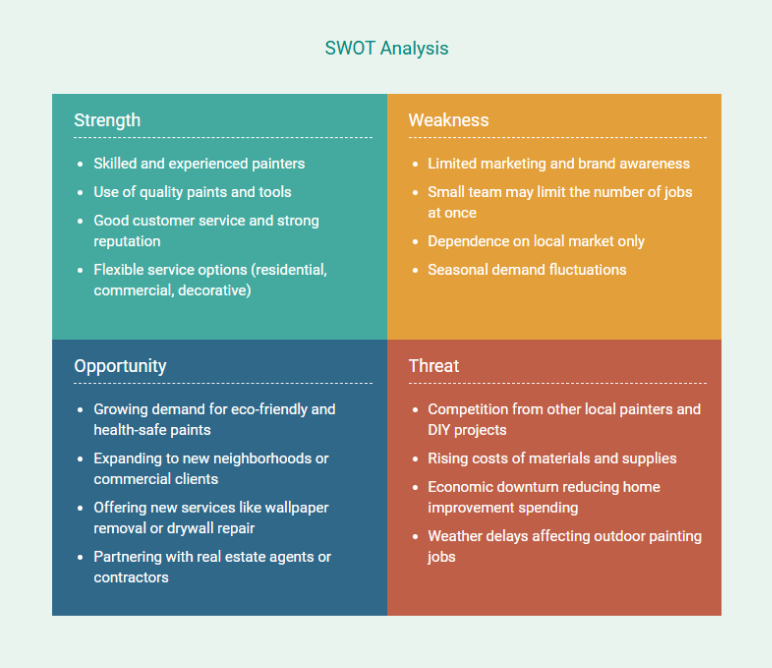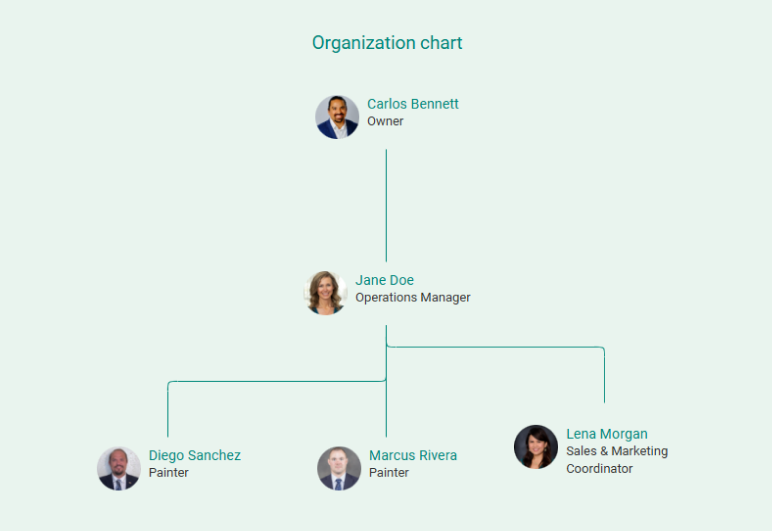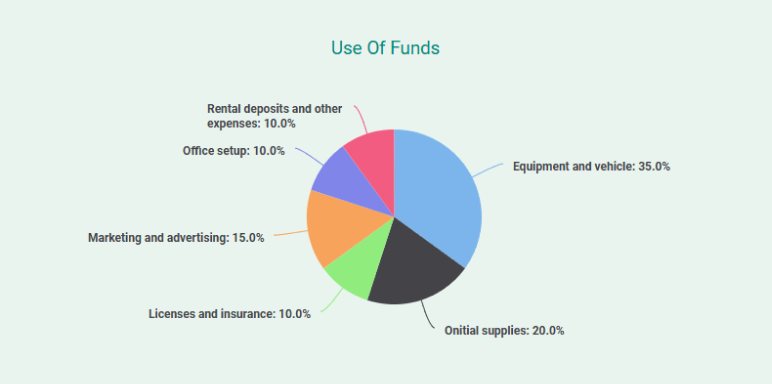Starting a painting business—whether for homes, commercial spaces, or specialty work like decorative painting—needs more than just talent with brushes.
To build a successful and profitable business, you need a clear plan.
A good business plan helps you figure out how to turn your skills into a steady income, set goals, and handle challenges.
Not sure how to draft a plan?
Don’t worry! This painting business plan template will walk you through the steps to create an actionable plan. But first…
What is a painting business plan?
A painting business plan is a professionally written document that serves as a clear roadmap for your painting company. It lays out your business goals and the steps you’ll take to reach them.
This plan explains your painting services, target customers, marketing ideas, daily operations, management, and financial outlook. Basically, it’s the blueprint for how your painting business will get started, run smoothly, and grow over time.
Why do you need a painting company business plan?
Every painting business should start with a plan. Here’s why it’s important:
- It helps you understand what your business will offer, how much you’ll charge, who your customers are, and how you’ll grow.
- If you need a loan or want to bring in investors, they’ll ask to see a plan. It shows you’ve thought about the money side of things.
- A plan also keeps you organized. It covers your marketing, daily work, and how you’ll handle your money, so you’re not guessing as you go.
- It helps you analyze problems early, like slow times of the year or extra costs, so you can be ready for them.
- And it lets you track your progress. You can check if you’re meeting your goals and make changes if needed.
In short, a business plan helps you stay focused and grow your painting business the right way.
How to write an effective painting business plan?
An effective painting business plan explains what your business does and how it plans to succeed.
Here’s a simple 9-step guide to help you put together a strong plan for your painting business:

1. Executive Summary
The executive summary is the first part of your painting company business plan. It gives a quick overview of your business and explains why it will succeed.
Even though it appears first, it’s best to write it last. Once the rest of your plan is complete, you’ll have all the key points you need to summarize here.
Key components to include in your executive summary:
- Your mission & vision statement
- Market opportunity in your area
- Services and specialties you offer
- Your target customers
- Your marketing & sales plan
- Basic financial highlights
Keep it clear and to the point. Avoid technical language. This might be the only part some people read—so make it strong, easy to follow, and interesting enough to get them excited about your painting business.
2. Company Overview
The company overview section provides detailed information about your painting business. This will give readers a clear understanding of who you are, what you do, and how your business is set up.
Here’s what to include in this section:
- Company description: Include your business name, location, and when you started or plan to start. Describe the type of painting services you offer, like residential, commercial, decorative, or interior/exterior work.
- Legal structure: Mention how the business is registered—sole proprietorship, partnership, LLC, or corporation. Add if you have any co-owners or partners.
- Business history: If your business is already running, say when it started and any important milestones. If you're just starting, talk about why you decided to open this painting business.
- Mission and values: Write what your business stands for. This could be doing quality work, keeping customers happy, being on time, or using eco-friendly paints.
- Future goals: Talk about what you want to achieve. Maybe you want to find more customers, grow your team, or offer more services in new areas.
In short, this section lays the foundation for your entire business plan. Keep it clear, friendly, and honest so readers can really understand your business.
3. Industry and Market Research
The market analysis section highlights your understanding of the painting industry, your ideal customers, and the overall market you’ll serve.
Here’s what to cover in your market analysis:
Industry Overview
Start with a short summary of the painting business. How big is it? Is it growing?
For example, the global market for paints and coatings is worth about $194.5 billion in 2024 and is expected to grow to $227.5 billion by 2029.
Use easy-to-understand facts or numbers to show that many people need painting services, especially in your area.
Target Customers
Define who your customers are. Are they homeowners or businesses? Which neighborhoods or groups do you want to serve?
You can also add a buyer persona to understand your target customer and their needs. Something like:

This will show that you understand what your customers really need and how your painting business will help them.
Market Trends
Talk about recent trends or new things happening in the painting industry, or what customers like. For example:
- Many painters use apps that show customers what paint colors look like before starting.
- Online meetings are more common now.
- People want paints that are better for health and the environment.
- Some paint colors and styles are getting popular.
- More people are fixing up their homes, so there are more painting jobs.
These show what’s new emerging in the market and what customers want.
Competitive Analysis
Start by researching other painting businesses in your area—these are your direct competitors. Also, consider indirect ones like DIY painters or general handymen.
Look at what your competitors do well and where they fall short. Consider things like their pricing, quality of work, and services offered.
You can also perform a quick SWOT analysis for your business. For example:

This simple analysis helps you think clearly about where your business fits in the market and how you can succeed by playing to your strengths and improving where needed.
Regulatory Environment
Finally, list any rules, licenses, or permits your business needs to follow, which may include:
- Business registration and licensing
- Contractor licenses
- Environmental regulations
Make sure to check your local city or state website to know exactly what applies to your business.
4. Services Offered
This section explains what services your painting business offers, so customers know exactly what they can hire you for.
Start by listing your main services, like:
- Painting inside and outside homes (walls, doors)
- Painting commercial spaces (offices, shops)
- Refinishing and painting cabinets
- Decorative painting (murals, special finishes)
Mention any special techniques or tools you use, such as eco-friendly paints or spray painting, that make your work unique.
You can also highlight any special packages or discounts if applicable. Maybe you could give a lower price for painting multiple rooms or offer seasonal deals for outdoor painting.
| Service | Starting Price | Description |
|---|---|---|
| Interior House Painting | $1.50 per sq. ft. | Includes walls, ceilings, and trim. Choice of colors. Prep, priming, and two coats included. |
| Exterior House Painting | $2.00 per sq. ft. | Full exterior painting with weather-resistant paint. Includes pressure washing, scraping, and priming. |
| Room Painting (Single) | $300 per room | Standard 12x12 room. Includes walls, minor repairs, and two coats of paint. |
| Commercial Painting | Custom Quote | For offices, retail, or warehouses. Includes flexible scheduling and safety compliance. |
| Cabinet Painting | $900 per kitchen | Clean, sand, prime, and paint kitchen cabinets with durable finish. |
| Fence & Deck Painting | $1.75 per sq. ft. | Includes sanding, sealing, and weatherproof paint or stain. |
| Touch-Up & Maintenance | $100 per visit | Minor fixes or touch-ups for existing paintwork. Ideal for property upkeep. |
Next, explain how you make sure your work is high quality:
- Do you review the work with customers?
- Do you use high-quality paints and tools?
- How do you fix things if the customer isn’t fully happy?
If you plan to add services in the future, mention that too, like touch-up kits or other offerings.
By the end of this section, readers should clearly know what your business does and why your services are a great choice.
5. Marketing and Sales Strategy
This section explains how you’ll attract customers and grow your painting business’s client base.
A well-thought-out marketing plan ensures that all the great services described in the previous section actually reach the people who need them.
The following are some marketing tactics and sales strategies you may consider including in your plan:
Marketing Strategies
- A professional website and local SEO
- Social media platforms like Instagram, YouTube, and Nextdoor
- Networking and partnerships with local real estate businesses
- Traditional marketing (flyers, yard signs, vehicle branding)
- Online advertising (Google Ads, Facebook Ads, lead platforms)
Sales Strategies
- Respond to inquiries promptly (within 24 hours)
- Offer free on-site consultations and detailed written estimates
- Follow up with potential clients who don’t immediately book
- Provide color consultations and friendly guidance during estimates
- Offer discounts for first-time clients or referral-based jobs
Overall, a focused marketing and sales strategy demonstrates a clear understanding of how to reach the target market effectively and persuade potential customers to choose your painting services over competitors.
6. Operations Plan
The operations plan explains how your painting business will run each day to keep things running smoothly. So, include all the important details about how your business works.
Here are the key aspects to cover in this section:
Operations & Service Delivery
Describe how you handle each job—from setting appointments and preparing surfaces to painting and checking the final result. Mention where you get your paint and tools, and how you keep track of jobs.
Daily Activities
List the main daily tasks such as:
- Meeting with clients
- Preparing and painting jobs
- Managing supplies and equipment
Staff Needed
Explain how many people you’ll hire and what they’ll do, such as painters or helpers. Also, mention if you’ll bring in experts for special jobs.
Tools and Supplies
Talk about the equipment you use, like brushes, rollers, ladders, and sprayers. Explain how you make sure you always have enough materials.
By covering these points, you show how your painting business will run efficiently, deliver quality work, and grow steadily over time.
7. Management Team
This part tells who is running the business and why they can make it succeed. Investors and lenders pay close attention to this part because a good idea needs the right people to execute it.
If you work alone, write a little about yourself. Explain what experience or skills you have that help with this business. Also, say what jobs you will do.
If you have additional team members, introduce them. Provide their roles and responsibilities, educational qualifications, skills, as well as relevant industry experience.
You can also include a simple organizational chart to explain who does what in the team and how decisions are made. For example:

Lastly, introduce advisors or mentors if you have an experienced person guiding you. It shows your business has external support and guidance to grow.
8. Financial Plan
The financial plan is one of the most important parts of your painting business plan. It shows if your business can make money and stay successful.
This section turns all your ideas into numbers—how much money you expect to earn, how much you’ll spend, and whether you’ll make a profit.
Here’s how to put together your financial plan:
Start by listing your startup costs—the one-time expenses needed to get your business going.
Next, explain how your business will make money. Give a sales forecast—how many painting jobs you expect to do and how much you’ll charge.
Also, list your ongoing costs. Some are fixed, like rent, insurance, or salaries. Others vary based on the number of jobs, such as paint, tools, and extra labor.
Then, include these three important financial reports:
- Profit & loss statement
- Cash flow statement
- Balance sheet
Use these to find your break-even point—when your income covers all your expenses and startup costs.
If you need money from a loan or investors, clearly say how much you want, what type of funding it is, and how you’ll use the money.
Here’s an example of a use of funds summary just for your reference:

Be honest about any financial risks and explain how you’ll handle them.
If you need any extra help creating realistic financial projections, consider talking to an accountant or using financial forecasting software.
9. Appendix
The appendix is where you put extra documents and details that support your painting business plan. You don’t always need an appendix, but it’s helpful for keeping important information that might make the main plan too long or crowded.
Here are some things you can include in your appendix:
- Detailed financial reports
- Market research information
- Resumes of key team members
- Legal papers like licenses or permits
- Samples of your painting work or portfolio
Keep the main plan clear and complete on its own. Use the appendix only for important details that support or back up your plan.
Avoid adding unnecessary items that may distract or confuse the reader.
Download a free painting business plan template
Creating a business plan for your painting business might seem tough, but you don’t have to start from scratch. We’ve created a free painting business plan template in PDF to make the process easier.
This template is designed specifically for painting business owners, with a ready-to-go outline and helpful prompts. You can use it as a framework, simply adding your own business details to make it unique to you.
Get help writing your plan
Now that you’ve gone through the guide and downloaded the free template, putting together your painting business plan should be much simpler.
However, if you’re still feeling unsure or need extra help, our team of experienced business plan writers and consultants is here to assist you!
We provide expert guidance, whether you need help with your financial projections, fine-tuning your market analysis, or making sure your plan is ready for investors.
Reach out to us! We’re here to help you make your painting business a success.
Frequently Asked Questions
Why do I need a business plan for my painting company?
Even if your painting business is small, keeping a plan really helps. It makes you think about who your customers are, how you’ll manage money, and what steps to take to grow. It’s like a roadmap to keep you on track. If you ever need a loan, most lenders will ask to see it. A good business plan helps you stay focused, avoid problems, and reach your goals.
What licenses or permits are required to start a painting business?
It depends on where you live, but here are some common things you might need:
- Business license
- Contractor’s license
- EPA lead-safe certification
- Sales tax permit
- DBA registration
- Job permits
- Environmental permits
Also, it’s a good idea to have insurance. General liability insurance protects you in case of accidents, and if you hire workers, you may need workers’ compensation insurance too.
Check with your local government to make sure you have everything you need before starting a painting business.
How to get funding for a painting business startup?
There are a few ways to get the money you need to start your painting business. What works best depends on your situation and how much you’re trying to raise:
- Use your own money
- Apply for a loan
- SBA loans
- Finance equipment
- Ask family or friends
- Crowdfunding
- Grants
What is the easiest way to write a painting business plan?
Using a painting business plan template can be the easiest way to write a plan. It provides a clear structure to follow and shows what to include in each section. Also, you can use business planning tools like Upmetrics to make the process a lot easier and draft solid plans in minutes.
How long should my painting business plan be?
The length of your business plan should be around 15 to 20 pages. Keep it simple and to the point. If it’s just for you, a shorter version (even 1-2 pages) with the basics like services, pricing, and goals is enough.
For investors or banks, include more details like market research, services, and financial plans. The key is to cover everything important, but don’t make it too long or complicated. Keep it clear and straightforward.

